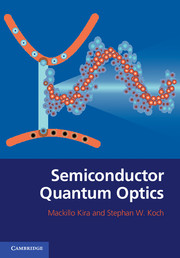Book contents
- Frontmatter
- Contents
- Preface
- 1 Central concepts in classical mechanics
- 2 Central concepts in classical electromagnetism
- 3 Central concepts in quantum mechanics
- 4 Central concepts in stationary quantum theory
- 5 Central concepts in measurement theory
- 6 Wigner's phase-space representation
- 7 Hamiltonian formulation of classical electrodynamics
- 8 System Hamiltonian of classical electrodynamics
- 9 System Hamiltonian in the generalized Coulomb gauge
- 10 Quantization of light and matter
- 11 Quasiparticles in semiconductors
- 12 Band structure of solids
- 13 Interactions in semiconductors
- 14 Generic quantum dynamics
- 15 Cluster-expansion representation of the quantum dynamics
- 16 Simple many-body systems
- 17 Hierarchy problem for dipole systems
- 18 Two-level approximation for optical transitions
- 19 Self-consistent extension of the two-level approach
- 20 Dissipative extension of the two-level approach
- 21 Quantum-optical extension of the two-level approach
- 22 Quantum dynamics of two-level system
- 23 Spectroscopy and quantum-optical correlations
- 24 General aspects of semiconductor optics
- 25 Introductory semiconductor optics
- 26 Maxwell-semiconductor Bloch equations
- 27 Coherent vs. incoherent excitons
- 28 Semiconductor luminescence equations
- 29 Many-body aspects of excitonic luminescence
- 30 Advanced semiconductor quantum optics
- Appendix Conservation laws for the transfer matrix
- Index
Preface
Published online by Cambridge University Press: 05 January 2012
- Frontmatter
- Contents
- Preface
- 1 Central concepts in classical mechanics
- 2 Central concepts in classical electromagnetism
- 3 Central concepts in quantum mechanics
- 4 Central concepts in stationary quantum theory
- 5 Central concepts in measurement theory
- 6 Wigner's phase-space representation
- 7 Hamiltonian formulation of classical electrodynamics
- 8 System Hamiltonian of classical electrodynamics
- 9 System Hamiltonian in the generalized Coulomb gauge
- 10 Quantization of light and matter
- 11 Quasiparticles in semiconductors
- 12 Band structure of solids
- 13 Interactions in semiconductors
- 14 Generic quantum dynamics
- 15 Cluster-expansion representation of the quantum dynamics
- 16 Simple many-body systems
- 17 Hierarchy problem for dipole systems
- 18 Two-level approximation for optical transitions
- 19 Self-consistent extension of the two-level approach
- 20 Dissipative extension of the two-level approach
- 21 Quantum-optical extension of the two-level approach
- 22 Quantum dynamics of two-level system
- 23 Spectroscopy and quantum-optical correlations
- 24 General aspects of semiconductor optics
- 25 Introductory semiconductor optics
- 26 Maxwell-semiconductor Bloch equations
- 27 Coherent vs. incoherent excitons
- 28 Semiconductor luminescence equations
- 29 Many-body aspects of excitonic luminescence
- 30 Advanced semiconductor quantum optics
- Appendix Conservation laws for the transfer matrix
- Index
Summary
A wide variety of quantum-optical effects can be understood by analyzing atomic model systems interacting with the quantized light field. Often, one can fully calculate and even measure the quantum-mechanical wave function and its dependence on both the atomic and the light degrees of freedom. By elaborating on and extending this approach, researchers perpetually generate intriguing results and new insights allowing for the exploration and utilization of effects encountered only in the realm of quantum phenomena.
By now, quantum-optical investigations have evolved from atoms all the way to complex systems, such as solids, in particular semiconductors. As a profound conceptual challenge, the optical transitions in semiconductors typically involve an extremely large number of electronic states. Due to their electric charge, the optically active electrons experience strong Coulomb interaction effects. Furthermore, they are coupled to the lattice vibrations of the solid crystal. For such an interacting many-body system, the overwhelmingly large number of degrees of freedom makes it inconceivable to measure the full wave function; we obviously need new strategies to approach semiconductor quantum optics. The combination of quantum-optical and many-body interactions not only leads to prominent modifications of the effects known from atomic systems but also causes new phenomena without atomic counterparts.
In this book, we develop a detailed microscopic theory for the analysis of semiconductor quantum optics. As central themes, we discuss how the quantum-optical approach can be systematically formulated for solids, which new aspects and prospects arise, and which conceptual modifications have to be implemented.
- Type
- Chapter
- Information
- Semiconductor Quantum Optics , pp. xi - xivPublisher: Cambridge University PressPrint publication year: 2011

